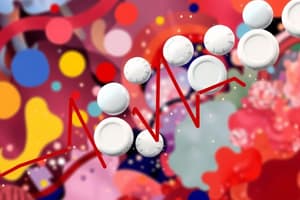Podcast
Questions and Answers
Which of the following are Class III antiarrhythmic drugs?
Which of the following are Class III antiarrhythmic drugs?
- Amiodarone
- Ibutilide
- Sotalol
- All of the above (correct)
What is the primary use of Amiodarone?
What is the primary use of Amiodarone?
Chronic control of atrial fibrillation and flutter, supraventricular and ventricular tachycardias, and ventricular fibrillation prophylaxis.
What is the mechanism of action for Amiodarone?
What is the mechanism of action for Amiodarone?
Blockade of K+ channels and inactivated Na+ channels, blockade of Ca2+ channels, slight noncompetitive blockade of α and β adrenoceptors.
What are the electrophysiological effects of Amiodarone?
What are the electrophysiological effects of Amiodarone?
Amiodarone increases the ______ interval significantly.
Amiodarone increases the ______ interval significantly.
What is a common adverse effect of Amiodarone?
What is a common adverse effect of Amiodarone?
In which conditions is Amiodarone contraindicated?
In which conditions is Amiodarone contraindicated?
What is the mechanism of action for Sotalol?
What is the mechanism of action for Sotalol?
What is Sotalol primarily used for?
What is Sotalol primarily used for?
What is a notable side effect of Sotalol?
What is a notable side effect of Sotalol?
When is Sotalol contraindicated?
When is Sotalol contraindicated?
What is the mechanism of action for Ibutilide?
What is the mechanism of action for Ibutilide?
What is the primary use of Ibutilide?
What is the primary use of Ibutilide?
What is a key contraindication for Ibutilide?
What is a key contraindication for Ibutilide?
Study Notes
Class III Antiarrhythmic Drugs
- Key members include Amiodarone, Ibutilide, and Sotalol.
- Primarily used for controlling arrhythmias and maintaining sinus rhythm.
Amiodarone (Class III)
- Most prescribed antiarrhythmic agent and considered highly effective.
- Used for chronic control of atrial fibrillation, supraventricular and ventricular tachycardias, and ventricular fibrillation prophylaxis.
- Main mechanism of action involves blockade of K+ channels and inactivated Na+ channels, with slight blockade of Ca2+ channels.
- Electrophysiological effects include decreased conduction, increased refractoriness, and decreased automaticity.
- ECG effects prominently feature increased PR interval, QRS duration, and markedly increased QT interval.
- Cardiovascular actions include vasodilation, reduced total peripheral resistance, and improved coronary blood flow, with minimal impact on cardiac contractility.
- Has multiple side effects including organ system effects, potential for serious cardiovascular complications, gastrointestinal issues, CNS disturbances, and pulmonary side effects.
- Contraindicated in congenital long QT syndrome, cardiogenic shock, sinus bradycardia, and pregnancy.
- Causes increased plasma levels of several drugs such as digoxin and warfarin due to reduced clearance.
Sotalol (Class III)
- Functions as a nonselective β blocker, increasing refractoriness by blocking K+ channels.
- Primarily used for supraventricular arrhythmias.
- Side effects related to β blockade, with a significant risk of torsade de pointes due to repolarization prolongation.
- Contraindicated in the setting of myocardial infarction and used cautiously for life-threatening ventricular arrhythmias only.
Ibutilide (Class III)
- Mechanism includes blocking K+ channels while also activating an inward Na+ current, prolonging action potential duration.
- Primarily indicated for atrial flutter and fibrillation, aiding in conversion to and maintenance of sinus rhythm.
- Associated adverse effects include AV block, bundle-branch block, ventricular tachycardia, and torsade de pointes.
- Contraindicated in patients with long QT interval and existing ventricular tachycardias.
Studying That Suits You
Use AI to generate personalized quizzes and flashcards to suit your learning preferences.
Description
Test your knowledge on Class III antiarrhythmic drugs with these flashcards. Learn key drugs like Amiodarone, Ibutilide, and Sotalol, along with their uses and effectiveness in treating various heart arrhythmias. Perfect for medical students and healthcare professionals!




